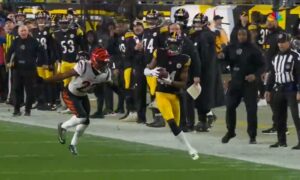By Matthew Marczi
It would be quite a challenge to ignore the recent trend around the league of employing two tight ends in the passing game by teams such as the Baltimore Ravens, the New England Patriots, the Indianapolis Colts, and others—including the Cincinnati Bengals after drafting tight end Tyler Eifert.
Yet the Pittsburgh Steelers have only very rarely incorporated multiple tight ends into the passing game. Certainly not in recent years. Given the injury to Heath Miller and the near certainty that he will need time to regain his form, even if he is able to play week one, it raises the question about how the Steelers have used their tight end depth in the passing game in recent memory—and how they have performed.
Last year, of course, the Steelers brought in Leonard Pope to serve as second fiddle to Miller as he helped the team transition to new offensive coordinator Todd Haley’s playbook, having played under him for both the Arizona Cardinals and the Kansas City Chiefs.
But Pope was ineffective in his role as second stringer, and it was not long before David Paulson, a rookie seventh round draft pick, surpassed him, ultimately playing nearly four times the amount of snaps as the veteran.
Still, neither player was targeted much. In fact, on over a third of Paulson’s passing snaps, he was asked exclusively to stay in and block, whereas almost 60% of Pope’s passing snaps were exclusively for pass protection.
Between the two, they only ran just over 100 routes, and combined for 11 targets. Pope caught all three of his targets, two of which went for touchdowns, while Paulson secured seven of his eight targets. Combined, the reserve tight ends netted 10 receptions for 60 yards and two touchdowns.
All told, Pope played less than 9% of the team’s snaps, while Paulson came in at just under 30%. Due to the duo’s inexperience, Miller was forced to remain exclusively in pass protection more than he had in years, perhaps in his entire career, with nearly a quarter of his snaps in the passing game asking him to block.
In comparison, he was relatively unburdened in 2011 with David Johnson and Weslye Saunders. Johnson played pass protect nearly a third of the time he was in on passing downs, while Saunders remained in to block on about 30% of his passing snaps. This duo was on the field more frequently than last year’s pair; Saunders saw action on over 20% of the team’s snaps, whereas Johnson’s usage exceeded 40%.
Still, they did not exactly make a splash in the passing game. Johnson caught 12 passes on 14 targets for 91 yards and a touchdown, while Saunders added four receptions on seven targets for 29 yards and a touchdown. Combined, that is 15 receptions for 120 yards and two scores.
Johnson, remember, primarily played in a more fullback-oriented role, and in fact had his struggles when the team tried to make him an inline blocker, so that must be noted in these statistics. In 2010 and his rookie year, he played nearly exclusively at fullback. In 2010, he caught four of six passes aimed his way for 46 yards.
2010 was also the last year in the first stint with Pittsburgh for Matt Spaeth, who is now back with the team. He got quite a lot of usage in 2010, playing just about half of the team’s snaps, and being asked to pass protect on nearly 30% of his passing snaps.
Still, he received 18 targets, catching only nine of them, with two deemed dropped passes. He totaled 80 yards and scored one touchdown. Add in Johnson’s production and the reserve tight ends amassed 13 receptions for 126 yards and one score in 2010.
Johnson saw little usage as a rookie in 2009. He played pass protect eight times out of his 23 passing snaps as a fullback and saw four targets in the passing game, catching two for nine yards. It was a two-man show at tight end, however, with Spaeth being the only other fulltime tight end.
Spaeth played over a third of the team’s snaps in 2009, though mostly as a run blocker. Of his nearly 400 snaps, barely 130 of them were in the passing game. Of those, over a third were in pass protection. He was ultimately targeted but six times, catching five for 25 yards and a score, making the total output for reserve tight ends that year seven catches for 34 yards and a score.
Going back one year further to 2008 brings us to another former hybrid player, Sean McHugh. Like Johnson earlier in his career, he played primarily fullback. Still, he saw just 16.6% of the team’s snaps, and only about a third of them came at tight end. Primarily a run blocker, he saw little time in the passing game, but he caught three passes on four targets for 24 yards.
Spaeth, meanwhile, had a more productive season, especially as a receiver, although 20% of his passing snaps were in pass protection. He was targeted a career-high 26 times and caught 17 passes for 136 yards. Unlike in 2007, however, when three of his five receptions netted a touchdown, 2008 was the only season in which he did not score.
All told, that is just 20 receptions for 160 yards and no scores. Below is a table chronicling the production in the passing game the Steelers have gotten out of their reserve tight ends over the past five seasons. Of course having Miller present skews the other tight ends’ production; however, reflecting on the data below, the Steelers are certainly hoping that Miller is able to return as soon as possible. If not, they will have to rely on some combination of Spaeth, Paulson, Johnon, and fullback Will Johnson to try to compensate for Miller’s loss.
| Year | Targets | Receptions | Comp. % | Yards | YPC | Touchdowns |
|---|---|---|---|---|---|---|
| 2012 | 11 | 10 | 91 | 60 | 6 | 2 |
| 2011 | 21 | 15 | 71.4 | 120 | 8 | 2 |
| 2010 | 24 | 13 | 54.2 | 126 | 9.7 | 1 |
| 2009 | 10 | 7 | 70 | 34 | 4.86 | 1 |
| 2008 | 30 | 20 | 66.7 | 160 | 8 | 0 |
| Average | 19.2 | 13 | 67.7 | 100 | 7.7 | 1.2 |







